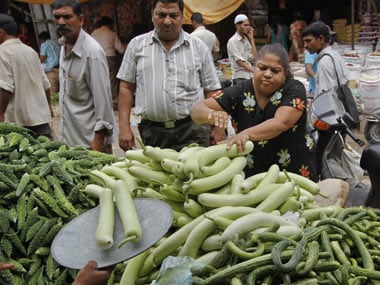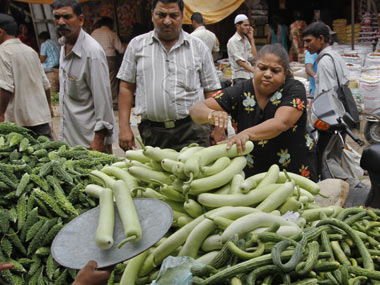Food prices have yet again turned as the villain in the inflation saga. A sharp jump in the prices of vegetables and fruits, has pushed the July wholesale price index- (WPI) based inflation to 3.55 percent from 1.62 percent in June. In other words, cumulatively, the wholesale price index has risen by 4.91 percent so far this fiscal year. As compared to this, this increase was only 0.85 percent in the same period last year. WPI began to rise for the first time in April after 17 straight months of contraction. Though no one takes serious note of WPI movements these days (since CPI is RBI’s core focus), this time WPI trends cannot be ignored. The simple reason is the trigger for both CPI and WPI is same– high food inflation. WPI food inflation rose to 11.82 percent in July from 8.18 percent in June. Most economists expect that the food inflation will ease by September on account of seasonal factors, statistics and a favourable monsoon. Even then, there are very few economists who believe that the central bank will be able to comfortably meet its March,2017 CPI inflation target of 5 percent and 4 percent a year later. “With a good monsoon this year, prices are expected to stabilize, however excess monsoon received by some regions would result in damage of crops which in turn could put upward pressure on prices. However, even though monsoon has been favorable, inflation is expected to continue to be under pressure,” Care rating agency said in a note on Monday. [caption id=“attachment_2783234” align=“alignleft” width=“380”]  Representative image[/caption] The central bank has been given a target of 4 percent (plus minus 2 percent) CPI inflation target by the Narendra Modi government till 2021. But as economists have pointed repeatedly, the central bank has very limited tools to fight what is structurally a supply side inflation. It would be a tough battle for both the RBI and the government to fight. The Modi government too has realised the nature of the problem and probably that is the reason why it agreed for the 4 percent target of the RBI even though it meant cautious approach from the RBI on rate cuts. Already the CPI has breached the 2-6 percent band of the RBI when the CPI inflation shot up beyond 6 percent in July at 6.07 percent. The CPI food index, in July rose from 137 to 138.8 (in percentage terms from 7.79 percent to 8.35 percent), the veg index rose to 165.5 from 159.7 (though percentage terms a tad lower at 14.06 percent from 14.81 in June). Similarly, pulses and products rose to 177.4 from 174.3 (in percentage terms 27.53 percent from 26.86 percent). The RBI had left its key rate unchanged in last Tuesday’s bi-monthly review citing upside risks to inflation. Since January, 2015, the central bank has slashed the RBI’s key lending rate, repo, by 150 basis points. One bps is one hundredth of a percentage point. If inflation eases considerably post September, the central bank might go for a quarter percentage cut in key rates in October or by year-end. Clearly, the inflation is the bigger evil in a country with sizeable chunk of poor and needs to be addressed first than anything else. The big relief is that the central bank now has an understanding with the government on the inflation-fight. The proposed joint monetary policy committee , which will have members from both the RBI and government will be operational later this year making the fight against inflation even more stronger. Raghuram Rajan stepped into the central bank amid the concern on high inflation among other worries. During his tenure, Rajan had won accolades from economists for controlling the inflation problem. It is bit of an irony that Rajan will exit from his job early next month with inflation yet again dominating as a major concern.
Food prices has yet again turned as the villain in the inflation saga. A sharp jump in the prices of vegetables and fruits, has pushed the July wholesale price index- (WPI) based inflation to 3.55 percent from 1.62 percent in June.
Advertisement
End of Article


)

)
)
)
)
)
)
)
)



